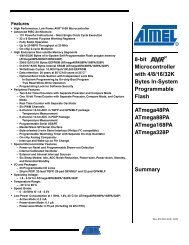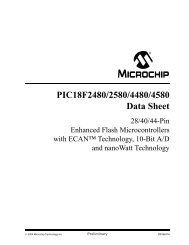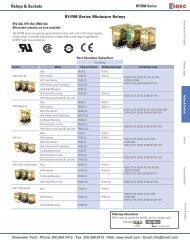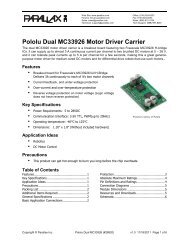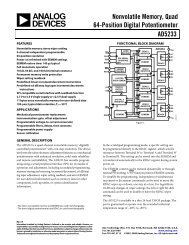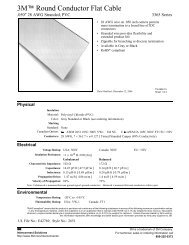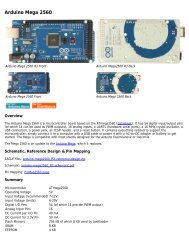FLEX 10KE Embedded Programmable Logic Device Data Sheet
FLEX 10KE Embedded Programmable Logic Device Data Sheet
FLEX 10KE Embedded Programmable Logic Device Data Sheet
Create successful ePaper yourself
Turn your PDF publications into a flip-book with our unique Google optimized e-Paper software.
<strong>FLEX</strong> <strong>10KE</strong> <strong>Embedded</strong> <strong>Programmable</strong> <strong>Logic</strong> <strong>Device</strong>s <strong>Data</strong> <strong>Sheet</strong><br />
Clearable Counter Mode<br />
The clearable counter mode is similar to the up/down counter mode, but<br />
supports a synchronous clear instead of the up/down control. The clear<br />
function is substituted for the cascade-in signal in the up/down counter<br />
mode. Use 2 three-input LUTs: one generates the counter data, and the<br />
other generates the fast carry bit. Synchronous loading is provided by a<br />
2-to-1 multiplexer. The output of this multiplexer is AND ed with a<br />
synchronous clear signal.<br />
Internal Tri-State Emulation<br />
Internal tri-state emulation provides internal tri-states without the<br />
limitations of a physical tri-state bus. In a physical tri-state bus, the<br />
tri-state buffers’ output enable (OE) signals select which signal drives the<br />
bus. However, if multiple OE signals are active, contending signals can be<br />
driven onto the bus. Conversely, if no OE signals are active, the bus will<br />
float. Internal tri-state emulation resolves contending tri-state buffers to a<br />
low value and floating buses to a high value, thereby eliminating these<br />
problems. The Altera software automatically implements tri-state bus<br />
functionality with a multiplexer.<br />
Clear & Preset <strong>Logic</strong> Control<br />
<strong>Logic</strong> for the programmable register’s clear and preset functions is<br />
controlled by the DATA3, LABCTRL1, and LABCTRL2 inputs to the LE. The<br />
clear and preset control structure of the LE asynchronously loads signals<br />
into a register. Either LABCTRL1 or LABCTRL2 can control the<br />
asynchronous clear. Alternatively, the register can be set up so that<br />
LABCTRL1 implements an asynchronous load. The data to be loaded is<br />
driven to DATA3; when LABCTRL1 is asserted, DATA3 is loaded into the<br />
register.<br />
During compilation, the Altera Compiler automatically selects the best<br />
control signal implementation. Because the clear and preset functions are<br />
active-low, the Compiler automatically assigns a logic high to an unused<br />
clear or preset.<br />
The clear and preset logic is implemented in one of the following six<br />
modes chosen during design entry:<br />
■<br />
■<br />
■<br />
■<br />
■<br />
■<br />
Asynchronous clear<br />
Asynchronous preset<br />
Asynchronous clear and preset<br />
Asynchronous load with clear<br />
Asynchronous load with preset<br />
Asynchronous load without clear or preset<br />
24 Altera Corporation



